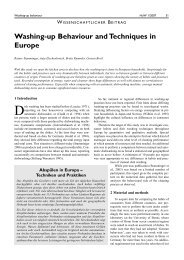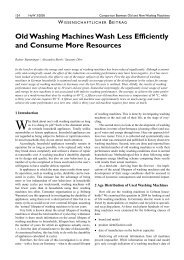Development of a novel mechatronic system for mechanical weed ...
Development of a novel mechatronic system for mechanical weed ...
Development of a novel mechatronic system for mechanical weed ...
Create successful ePaper yourself
Turn your PDF publications into a flip-book with our unique Google optimized e-Paper software.
Introduction<br />
be to go from a <strong>system</strong> <strong>of</strong> “risk” assessment – where potential hazard is<br />
weighed in terms <strong>of</strong> likelihood <strong>of</strong> actual exposure and contamination – to a<br />
purely “hazard” based assessment – only potential harm is evaluated, with no<br />
consideration <strong>of</strong> actual likelihood <strong>of</strong> exposure.<br />
6<br />
1.1.1 Impact <strong>of</strong> pesticide application on groundwater<br />
sources<br />
One <strong>of</strong> the most worrisome effects <strong>of</strong> pesticide use is water contamination.<br />
About 65% <strong>of</strong> drinking water primary sources in Europe rely on ground waters,<br />
making the possible groundwater contamination extremely dangerous.<br />
EUREAU, the European union <strong>of</strong> national associations <strong>of</strong> water suppliers and<br />
waste water services, published a report in 2001 stating that the areas at<br />
greatest risk in Europe where those containing lowland rivers, in particular in<br />
north-western Europe in countries bordering the Netherlands such as Belgium<br />
and Germany. Germany was among six countries listed as one <strong>of</strong> the “most<br />
affected countries” which have between 5-10% <strong>of</strong> their water resources<br />
regularly contaminated by pesticides over the EU established maximum <strong>of</strong> 0.1<br />
µg/l (EUREAU 2001). The ECNC, European Centre <strong>for</strong> Nature Conservation,<br />
confirmed this in 2003 with environmental risk assessment, stating the risk <strong>for</strong><br />
aquatic contamination from pesticides. The highest contamination was<br />
monitored in northern Italy and the area around the Netherlands and northwest<br />
Germany. The highest concentrations <strong>of</strong> herbicides were generally found during<br />
the spraying season (Kudsk and Streibig 2003). Because <strong>of</strong> the varying types <strong>of</strong><br />
pesticides and methods <strong>of</strong> application in use today, pollution can occur in many<br />
ways. These ways include leeching into underground rivers, waste disposal and<br />
wash down <strong>of</strong> equipment, and atmospheric deposition (EUREAU 2001). The<br />
costs <strong>of</strong> monitoring and removing pesticides from drinking water are extremely<br />
high. For example, during the period from 1991-2000 244 mil Euro were spent<br />
by the Dutch water industry on analysis, protection, and purification <strong>of</strong> water,<br />
due to pesticide contamination. Nearly 130 mil Euro were the estimated annual<br />
cost <strong>of</strong> pesticide use in Germany, taking into account monitoring costs,<br />
production losses, and labour (Waibel and Fleischer 1998).





